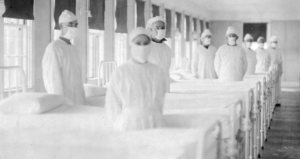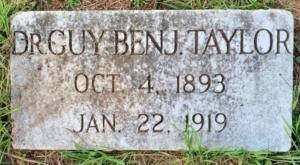Scroll of Honor – Guy Benjamin Taylor
Navy Doctor
Written by: Kelly Durham
Guy Benjamin Taylor of Lexington entered Clemson in 1912. Upon completion of his junior year in the spring of 1915, Taylor enrolled at the Medical College of South Carolina. His graduation with a medical degree coincided with the United States’ declaration of war on Germany in April 1917. Taylor immediately reported for active duty as a Navy lieutenant (junior grade).
The new Navy doctor was soon sent to France and England where he tended to wounded and sick soldiers. With the end of the war in November 1918, the Army began to send its troops home. The tight confines aboard troop ships ensured that the soldiers weren’t the only passengers. Along for the voyage was the Spanish Influenza. The first wave of the deadly flu had appeared in early 1918. Now, assisted by the return of soldiers to points all across the United States, a more deadly second wave was poised to break.

Corpsmen await patients at a Navy influenza ward in December 1918.
Lieutenant Taylor reached the United States at the beginning of December and was assigned to the Long Island Naval Hospital in Brooklyn, New York. Soon, the hospital was filling with flu patients. The first wave of the pandemic had resembled typical flu epidemics of the past, with the sick and elderly at the greatest risk. This second wave broke from the usual pattern. Now, twenty to forty-year-olds—which included most of the returning soldiers—experienced high mortality rates even among otherwise healthy people.
Like 2020’s Covid-19, the Spanish Flu was highly contagious, spreading easily from person to person through coughs and sneezing. Even mild cases of the flu could severely weaken the body’s immune system. The flu constricted and inflamed the body’s airways, slowing down the movement of air and reducing the body’s ability to clear mucus. With more mucus in the body, bacteria was more likely to form. The combination of a weakened immune system and the buildup of virus and bacteria often led to pneumonia, an inflammation of the lungs leading to high fever and difficulty breathing.
With no vaccines available, officials attempted to limit the spread of the flu through non-pharmaceutical interventions like isolation, quarantine, good personal hygiene, and reduced public gatherings, but these interventions were unevenly applied. Lieutenant Taylor, surrounded by sick patients, contracted the flu himself. Falling into one of the more susceptible demographic groups and without antibiotics with which to treat his infection, Taylor’s flu soon advanced to pneumonia, from which he died on January 23, 1919.
Dr. Taylor was described as “a young man of strong character, striking personality, and unusual ability with a bright future before him.” Instead of that “bright future,” Taylor became one of the estimated  300,000 Americans who died from the Spanish Flu between September 1918 and January 1919.
300,000 Americans who died from the Spanish Flu between September 1918 and January 1919.
Dr. Taylor was survived by his father and was buried at the Shiloh Methodist Church in Lexington.
For more information on Lieutenant Guy Benjamin Taylor see:
https://soh.alumni.clemson.edu/scroll/guy-benjamin-taylor/
For additional information about Clemson University’s Scroll of Honor visit:
https://soh.alumni.clemson.edu/
